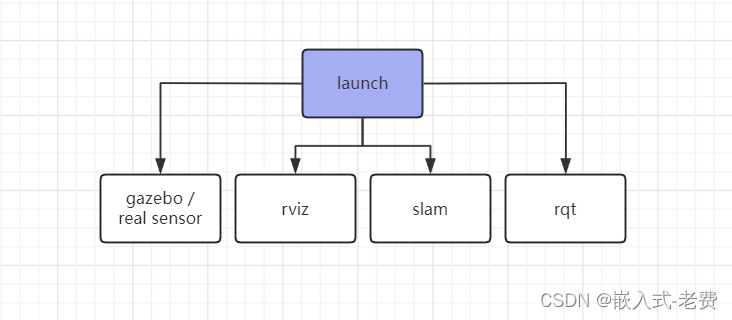【 声明:版权所有,欢迎转载,请勿用于商业用途。 联系信箱:feixiaoxing @163.com】
大家应该还记得我们在一开始学习ros的时候,如果需要启动一个节点的话,需要首先打开roscore,接着用rosrun打开对应的节点。如果节点比较少的话,这种方法,倒也可以接受,但是节点一多就不太方便了。比如,我们之前在学习slam的时候,需要依次打开gazebo、rviz、slam、rqt等多个节点软件,这就非常麻烦了。所以为了解决这个问题,人们想出了roslaunch的办法,它不但可以帮助我们自动打开roscore,还会自动打开脚本中每一个node节点,还能自由配置参数信息。
所以,对于我们来说,有必要学习好launch、用好launch。至于怎么学习,个人觉得最好的学习方法就是把曾经用过的launch文件直接拿过来分析就可以了。学完了,直接拿过来当模板修改使用。

1、wpb_simple.launch
<launch><!-- We resume the logic in empty_world.launch, changing only the name of the world to be launched --><include file="$(find gazebo_ros)/launch/empty_world.launch"><arg name="world_name" value="$(find wpr_simulation)/worlds/wpb_simple.world"/><arg name="paused" value="false"/><arg name="use_sim_time" value="true"/><arg name="gui" value="true"/><arg name="recording" value="false"/><arg name="debug" value="false"/></include><!-- Spawn the objects into Gazebo --><node name="bookshelft" pkg="gazebo_ros" type="spawn_model" args="-file $(find wpr_simulation)/models/bookshelft.model -x 3.0 -y 0.2 -z 0 -Y 3.14159 -urdf -model bookshelft" /><node name="bottle" pkg="gazebo_ros" type="spawn_model" args="-file $(find wpr_simulation)/models/bottles/red_bottle.model -x 2.8 -y 0 -z 0.6 -Y 0 -urdf -model red_bottle" /><!-- Spawn a robot into Gazebo --><node name="spawn_urdf" pkg="gazebo_ros" type="spawn_model" args="-file $(find wpr_simulation)/models/wpb_home.model -urdf -model wpb_home" /><!-- Robot Description --><arg name="model" default="$(find wpr_simulation)/models/wpb_home.model"/><param name="robot_description" command="$(find xacro)/xacro $(arg model)" /><node name="joint_state_publisher" pkg="joint_state_publisher" type="joint_state_publisher" /><node name="robot_state_publisher" pkg="robot_state_publisher" type="robot_state_publisher" />
</launch>内容看上很多,其实大部分都是描述仿真环境的。从一开始的empty_world.launch,到后来的objects、robot都是如此,最后添加了一个robot的详细描述。注意,node就是调用节点的地方,pkg代表包名,type代表node名,次序不重要。
仿真环境部分,world类似于装修里面的硬装,通常是一些围墙、灯光、地面的设置。objects是软装,书柜、瓶子就是objects。robot代表着人。硬装和软装都ok了之后,robot就可以在里面自由行走了。
2、wpb_gmapping.launch
<launch><!-- 载入 机器人 和 RoboCup@Home 的仿真场景 --><include file="$(find wpr_simulation)/launch/wpb_stage_robocup.launch"/><!-- Gmapping --><node pkg="gmapping" type="slam_gmapping" name="slam_gmapping"/><!-- Rviz --><arg name="rvizconfig" default="$(find wpr_simulation)/rviz/slam.rviz" /><node name="rviz" pkg="rviz" type="rviz" args="-d $(arg rvizconfig)" required="true" /><!-- 手柄控制 --><node respawn="true" pkg="joy" type="joy_node" name="joy_node" ><param name="dev" type="string" value="/dev/input/js0" /><param name="deadzone" value="0.12" /></node><param name="axis_linear" value="1" type="int"/><param name="axis_angular" value="0" type="int"/><param name="scale_linear" value="0.5" type="double"/><param name="scale_angular" value="1" type="double"/><node pkg="wpr_simulation" type="teleop_js_node" name="teleop_js_node"/></launch>相比较之前wpb_simple.launch文件,这个wpb_gmapping内容要丰富一些。首先,它嵌套了wpb_stage_robocup.launch的内容。接着启动gmapping和rviz,最后加载joy_node和teleop_js_node。不过印象中,实际调试的时候,最后还是通过rqt_robot_steering来调试的。
通过观察我们还发现,有些param是放在node里面的,这其实代表了私有参数;还有些param是放在外面的,这代表了公有参数,使用的时候需要稍微注意下。
3、wpb_corridor_hector.launch
<launch><!-- 载入 机器人 和 长走廊 的仿真场景 --><include file="$(find wpr_simulation)/launch/wpb_stage_corridor.launch"/><!-- Hector --><node pkg="hector_mapping" type="hector_mapping" name="hector_mapping"/><!-- Rviz --><arg name="rvizconfig" default="$(find wpr_simulation)/rviz/corridor.rviz" /><node name="rviz" pkg="rviz" type="rviz" args="-d $(arg rvizconfig)" required="true" /><!-- 运动控制 --><node pkg="rqt_robot_steering" type="rqt_robot_steering" name="rqt_robot_steering"/></launch>这个launch文件基本就是大家想要的那种launch文件。它包含了wpb_stage_corridor.launch的嵌套、hector算法、rviz和rqt_robot_steering。其中arg比较有意义,它本身相当于全局变量,供其他param参考使用的。
另外就是rviz里面的rvizconfig变量,它通过find找到corridor.rviz这个文件,最后被rviz这个node所使用。
4、wpb_navigation.launch
<launch><!-- We resume the logic in empty_world.launch, changing only the name of the world to be launched --><include file="$(find gazebo_ros)/launch/empty_world.launch"><arg name="world_name" value="$(find wpr_simulation)/worlds/robocup_home.world"/><arg name="paused" value="false"/><arg name="use_sim_time" value="true"/><arg name="gui" value="true"/><arg name="recording" value="false"/><arg name="debug" value="false"/></include><!-- Spawn the objects into Gazebo --><node name="bed" pkg="gazebo_ros" type="spawn_model" args="-file $(find wpr_simulation)/models/bed.model -x 5.0 -y -3.9 -z 0 -Y 3.14159 -urdf -model bed" /><node name="sofa" pkg="gazebo_ros" type="spawn_model" args="-file $(find wpr_simulation)/models/sofa.model -x -1.0 -y -3.9 -z 0 -Y 1.57 -urdf -model sofa" /><node name="tea_table" pkg="gazebo_ros" type="spawn_model" args="-file $(find wpr_simulation)/models/tea_table.model -x -2.1 -y -2.2 -z 0 -Y 1.57 -urdf -model tea_table" /><node name="bookshelft" pkg="gazebo_ros" type="spawn_model" args="-file $(find wpr_simulation)/models/bookshelft.model -x 2.0 -y -0.55 -z 0 -Y -1.57 -urdf -model bookshelft" /><node name="kitchen_table" pkg="gazebo_ros" type="spawn_model" args="-file $(find wpr_simulation)/models/table.model -x -3.5 -y 3.7 -z 0 -Y 1.57 -urdf -model kitchen_table" /> <node name="cupboard_0" pkg="gazebo_ros" type="spawn_model" args="-file $(find wpr_simulation)/models/cupboard.model -x -2.0 -y 0.7 -z 0 -Y 1.57 -urdf -model cupboard_0" /><node name="cupboard_1" pkg="gazebo_ros" type="spawn_model" args="-file $(find wpr_simulation)/models/cupboard.model -x -1.3 -y 3.7 -z 0 -Y -1.57 -urdf -model cupboard_1" /> <node name="dinning_table_0" pkg="gazebo_ros" type="spawn_model" args="-file $(find wpr_simulation)/models/table.model -x 1.5 -y 1.5 -z 0 -Y 1.57 -urdf -model dinning_table_0" /><node name="dinning_table_1" pkg="gazebo_ros" type="spawn_model" args="-file $(find wpr_simulation)/models/table.model -x 1.5 -y 2.0 -z 0 -Y 1.57 -urdf -model dinning_table_1" /><node name="dinning_table_2" pkg="gazebo_ros" type="spawn_model" args="-file $(find wpr_simulation)/models/table.model -x 2.7 -y 1.5 -z 0 -Y 1.57 -urdf -model dinning_table_2" /><node name="dinning_table_3" pkg="gazebo_ros" type="spawn_model" args="-file $(find wpr_simulation)/models/table.model -x 2.7 -y 2.0 -z 0 -Y 1.57 -urdf -model dinning_table_3" /><node name="chair_0" pkg="gazebo_ros" type="spawn_model" args="-file $(find wpr_simulation)/models/chair.model -x 1.5 -y 1.2 -z 0 -Y 1.57 -urdf -model chair_0" /><node name="chair_1" pkg="gazebo_ros" type="spawn_model" args="-file $(find wpr_simulation)/models/chair.model -x 1.5 -y 2.3 -z 0 -Y -1.57 -urdf -model chair_1" /><node name="chair_2" pkg="gazebo_ros" type="spawn_model" args="-file $(find wpr_simulation)/models/chair.model -x 2.7 -y 1.2 -z 0 -Y 1.57 -urdf -model chair_2" /><node name="chair_3" pkg="gazebo_ros" type="spawn_model" args="-file $(find wpr_simulation)/models/chair.model -x 2.7 -y 2.3 -z 0 -Y -1.57 -urdf -model chair_3" /><!-- Spawn a robot into Gazebo --><node name="spawn_urdf" pkg="gazebo_ros" type="spawn_model" args="-file $(find wpr_simulation)/models/wpb_home.model -urdf -x -6.0 -y -0.5 -model wpb_home" /><!-- Run the map server --><node name="map_server" pkg="map_server" type="map_server" args="$(find wpr_simulation)/maps/map.yaml"/><!--- Run AMCL --><include file="$(find wpb_home_tutorials)/nav_lidar/amcl_omni.launch" /><!--- Run move base --><node pkg="move_base" type="move_base" respawn="false" name="move_base" output="screen"><rosparam file="$(find wpb_home_tutorials)/nav_lidar/costmap_common_params.yaml" command="load" ns="global_costmap" /><rosparam file="$(find wpb_home_tutorials)/nav_lidar/costmap_common_params.yaml" command="load" ns="local_costmap" /><rosparam file="$(find wpb_home_tutorials)/nav_lidar/local_costmap_params.yaml" command="load" /><rosparam file="$(find wpb_home_tutorials)/nav_lidar/global_costmap_params.yaml" command="load" /><rosparam file="$(find wpb_home_tutorials)/nav_lidar/local_planner_params.yaml" command="load" /><param name="base_global_planner" value="global_planner/GlobalPlanner" /> <param name="use_dijkstra" value="true"/><param name="base_local_planner" value="wpbh_local_planner/WpbhLocalPlanner" /><param name= "controller_frequency" value="10" type="double"/></node><!-- RViz and TF tree --><arg name="model" default="$(find wpb_home_bringup)/urdf/wpb_home.urdf"/><arg name="gui" default="false" /><arg name="rvizconfig" default="$(find wpr_simulation)/rviz/nav.rviz" /><param name="robot_description" command="$(find xacro)/xacro $(arg model)" /><param name="use_gui" value="$(arg gui)"/><node name="robot_state_publisher" pkg="robot_state_publisher" type="robot_state_publisher"/><node name="joint_state_publisher" pkg="joint_state_publisher" type="joint_state_publisher" ><rosparam command="load" file="$(find wpb_home_bringup)/config/wpb_home.yaml" /></node><node name="rviz" pkg="rviz" type="rviz" args="-d $(arg rvizconfig)" required="true" /></launch>这个是目前为止最复杂的launch文件,不过好在有注释说明,还不算太难理解。从一开始的仿真环境说明gazebo,到后来的map_server、amcl、move_base、rviz和tf等节点工具,内容稍多了一点。这其中和之前不一样的,就是robot_state_publisher和joint_state_publisher两个节点,他们是和gazebo紧密配合一起使用的。
另外场景搭建的时候,我们也发现环境model和机器人model一般是分开来的。前者用spawn_model,后者用spawn_urdf。毕竟,相比较简单的环境model,urdf还会多一个传感器的插件功能,这才是我们仿真robot所真正在意和关心的。
5、总结
对于launch这类脚本的学习,个人建议直接看模板比较好一点,至少说先用起来。这样遇到问题再去找答案,或许效率更高一点。对于仿真环境部分的搭建部分,如果有兴趣可以看一看、学习下。兴趣不大的话,暂时掠过,或者直接复用别人搭建好的仿真环境,这都是可以的。





奖励政策及申报对比)













需求分析方法)